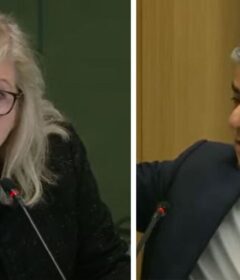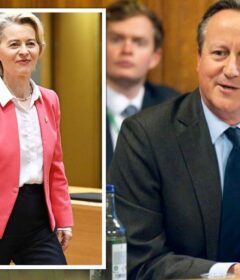Threats From Trump Often Fall Short
WASHINGTON — For President Trump, a threat is frequently his first impulse.
He is forceful, declarative and speaks with unvarnished conviction. He has made the theme of promises made, promises kept the anthem of his re-election effort.
But his threats often remain just that. The most recent example was when Mr. Trump backed down from a vow to close the border with Mexico, instead saying he would give one of the United States’ most essential trading partners a year to deal with the migrant crisis. This came only a day after he had threatened to act if Congress did not bend to his will on the issue. The price of Mexican avocados spiked, but the government of Mexico seemed unmoved.
(Mr. Trump has warned Mexico of an impending border closing at least three times before, in October, November and December.)
On Friday, before leaving for a trip to the border town of Calexico, Calif., Mr. Trump suggested that his threat against Mexico was still in his holster. “I never changed my mind at all. I may shut it down at some point, but I’d rather do tariffs,” he said.
Here is a look at some of Mr. Trump’s more high-profile threats.
Closing the border with Mexico
In retreating from his threat to close the border, Mr. Trump was withdrawing the warning that he issued strongly last week. But on Friday, he offered up another one. He said that the trade deal that the United States had reached with Mexico and Canada, known as the U.S.M.C.A., would not apply if Mexico does not stop Central American migrants from illegally entering the United States.
“If for any reason Mexico stops apprehending and bringing the illegals back to where they came from, the U.S. will be forced to Tariff at 25% all cars made in Mexico and shipped over the Border to us. If that doesn’t work, which it will, I will close the Border,” Mr. Trump wrote on Twitter.
“This will supersede USMCA,” Mr. Trump added. He also threatened an “economic penalty” on Mexico “for the 500 Billion Dollars in illegal DRUGS that are shipped and smuggled through Mexico and across our Southern Border.”
Congress has not yet voted on the trade deal. If it does approve the pact — and the president tried to unilaterally abrogate selective provisions of the agreement — it would provoke numerous legal challenges, as well as an uproar from foreign leaders and members of Congress.
A bullhorn to Russia
The president warned Russia in March to “get out” of Venezuela after Moscow dispatched military personnel to the country and offered to send the government of President Nicolás Maduro shipments of food and medicine. He has consistently said that Mr. Maduro must step down and has strongly suggested that United States military intervention was on the table. He also urged the Venezuelan military to rebel. None of those threats have been effective. Mr. Trump has accused the Russian government of bolstering Mr. Maduro while the United States has been rallying support behind Juan Guaidó, the opposition leader.
While the United States issued another round of sanctions and visa restrictions last month, Russia has shown no outward signs of backing down, and Mr. Maduro has refused Mr. Trump’s calls that he resign.
Telling General Motors to reopen a plant, or else (he would cut subsidies)
Mr. Trump has frequently threatened companies, particularly if they were moving jobs overseas. He has directed some of his sharpest language toward General Motors, and Mary Barra, its chief executive. He has demanded that G.M. reopen a plant in Lordstown, Ohio, that the company said it closed because consumer demand had shifted away from the smaller vehicles produced at the plant. He had earlier threatened to cut subsidies for the company and to recoup federal money it had received from the bailout at the height of the financial crisis of 2008.
The company has not acceded to his demands, and so far has not suffered any penalty from the government.
Threats against the media
Beyond regular Twitter posts denouncing the “fake news,” Mr. Trump has also threatened to take regulatory and legal actions against news outlets and television programs.
In October 2017, Mr. Trump suggested that he would revoke NBC’s broadcast license after the network published a report he objected to — only to be indirectly refuted days later by Ajit Pai, the chairman of the Federal Communications Commission, who said that his agency “does not have the authority to revoke a license of a broadcast station based on the content.” Nonetheless, Mr. Trump revived the threat in September 2018.
One program on the network in particular has drawn the president’s ire: “Saturday Night Live,” which Mr. Trump has said “should be tested in courts,” investigated by the F.C.C. or — rather vaguely — “should be looked into.”
In the fall, after the White House suspended the credentials of Jim Acosta, the chief White House correspondent for CNN, Mr. Trump threatened retaliation against other reporters if they did not “treat the White House with respect.”
Mr. Acosta’s press badge was restored and no other White House reporters have had their credentials suspended since.
Trying to overturn a constitutional right
Mr. Trump also threatened in 2018 to end birthright citizenship, a constitutional guarantee that could only be undone by amending the Constitution. In an interview with Axios at the time, the president called the concept “ridiculous” and said “it has to end.”
After strong pushback from within his party — Paul D. Ryan, the House speaker at the time, said the president “obviously” could not terminate a constitutional right by executive order — Mr. Trump retreated.
California on his mind
The liberal state has drawn Mr. Trump’s displeasure — and Twitter threats — several times during his presidency.
In November, Mr. Trump blamed wildfires ravaging California on what he deemed “gross mismanagement of the forests,” warning the state to “remedy now, or no more Fed payments!” (The criticism was misleading, as the majority of California’s forests are federally managed, and the causes of wildfires are complicated and include climate change.)
Two months later, in January, Mr. Trump said that state officials had not made adequate remedy and reissued his threat, “Unless they get their act together, which is unlikely, I have ordered FEMA to send no more money,” referring to the Federal Emergency Management Agency.
The state scrambled to make sense of Mr. Trump’s renewed threat, and lawmakers from both parties criticized the move. A month later, a spokesman for FEMA told BuzzFeed it had never received a directive.
The agency continued to provide assistance to residents affected by the fire. On the same day that Mr. Trump delivered his second warning, FEMA extended the deadline for California residents to apply for disaster assistance to Feb. 15. (It had been Jan. 31.) Federal cost-sharing for debris removal actually increased to 90 percent from 75 percent, and the agency provided more than $347 million in grants and loans to affected residents.
A veiled warning to James B. Comey
After he fired James B. Comey, the former F.B.I. director, in May 2017, Mr. Trump urged him to think twice about speaking with reporters and referred to secret recordings of their conversations.
“James Comey better hope that there are no ‘tapes’ of our conversations before he starts leaking to the press!” Mr. Trump wrote on Twitter.
For weeks, Mr. Trump and his aides refused to confirm or deny the existence of such recordings or to clarify if he was simply rebutting Mr. Comey’s claims that he had been asked by the president to pledge his loyalty.
Mr. Comey testified before Congress in June, telling lawmakers, “Lordy, I hope there are tapes.”
Mr. Trump then cleared it up himself on Twitter, denying that he had taped Mr. Comey in the first place: “I have no idea whether there are ‘tapes’ or recordings of my conversations with James Comey, but I did not make, and do not have, any such recordings.”
Michael Tackett covers national politics. He has written about politics for more than 30 years and has covered six presidential elections. @tackettdc
Linda Qiu is a fact-check reporter, based in Washington. She came to The Times in 2017 from the fact-checking service PolitiFact. @ylindaqiu
Source: Read Full Article


